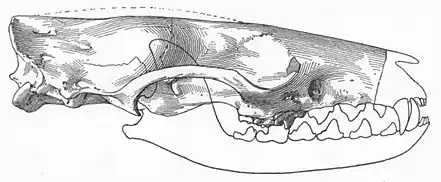Miacoidea
Miacoidea ("small points") is a former paraphyletic superfamily of extinct placental mammals that lived during the Paleocene and Eocene epochs, about 66-33,9 million years ago.[2][3][4][5][6][7] This group had been traditionally divided into two families of primitive carnivorous mammals: Miacidae (the miacids) and Viverravidae (the viverravids). These mammals were basal to order Carnivora, the crown-group within the Carnivoramorpha.
| Miacoidea | |
|---|---|
 | |
| skull of Miacis parvivorus | |
 | |
| skull of Viverravus minutus | |
| Scientific classification | |
| Domain: | Eukaryota |
| Kingdom: | Animalia |
| Phylum: | Chordata |
| Class: | Mammalia |
| Clade: | Carnivoramorpha |
| Superfamily: | †Miacoidea Cope, 1880[1] |
| Families | |
| |
Biology
Miacoids were mostly small carnivorous mammals, superficially reminiscent of martens or civets. They probably fed on invertebrates, lizards, birds and smaller mammals like shrews and rodents, while others may have been insectivores. Some species were arboreal, others lived on the ground. Their teeth and skull show that the miacoids were less developed than modern carnivores.
Classification
- Superfamily: †Miacoidea (Cope, 1880)
- Family: †Miacidae (Cope, 1880)
- Family: †Viverravidae (Wortman & Matthew, 1899)
- Incertae sedis:
- †"Sinopa" insectivorus (Cope, 1872)
References
- E. D. Cope (1880.) "On the genera of the Creodonta." Proceedings of the American Philosophical Society 19:76-82
- J. J. Hooker (1986.) "Mammals from the Bartonian (middle/late Eocene) of the Hampshire Basin, southern England." Bulletin of the British Museum (Natural History) 39(4):191-478
- Robert L. Carroll (1988.) "Vertebrate Paleontology and Evolution." W. H. Freeman and Company, New York, Miacoidea
- McKenna, Malcolm C.; Bell, Susan K. (1997). Classification of Mammals Above the Species Level. New York: Columbia University Press. ISBN 978-0-231-11012-9. Retrieved 16 March 2015.
- J. J. Flynn (1998.) "Early Cenozoic Carnivora ("Miacoidea")." In C. M. Janis, K. M. Scott and L. L. Jacobs (eds.) "Evolution of Tertiary Mammals of North America. Volume 1: Terrestrial Carnivores, Ungulates, and Ungulatelike Mammals." Cambridge University Press, Cambridge. ISBN 9780521355193
- T. J. Meehan and R. W. Wilson (2002) "New viverravids from the Torrejonian (Middle Paleocene) of Kutz Canyon, New Mexico and the oldest skull of the order Carnivora." Journal of Paleontology 76(6):1091-1101
- K. D. Rose, A. E. Chew, R. H. Dunn, M. J. Kraus, H. C. Fricke and S. P. Zack (2012) "Earliest Eocene mammalian fauna from the Paleocene-Eocene Thermal Maximum at Sand Creek Divide, southern Bighorn Basin, Wyoming." University of Michigan Papers on Paleontology 36:1-122